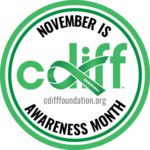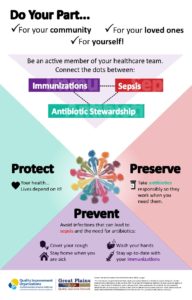
Clostridioides difficile (C. diff) is a germ that causes diarrhea and inflammation of the colon. The CDC estimates C. diff impacts almost half a million people in the United States each year and an estimated 29,300 deaths. C. diff is a bacteria spread by microscopic spores which cause inflammation of the gut or colon – colitis. This can lead to moderate-to-severe diarrhea, and sometimes sepsis, which can develop as the body tries to fight the infection. Sepsis is a life-threatening complication of C. diff that can lead to tissue damage, organ failure and death.
 This November – C. diff Awareness Month – we will work to raise awareness and help slow the spread of this deadly infection.
This November – C. diff Awareness Month – we will work to raise awareness and help slow the spread of this deadly infection.
Did you know? Most cases of C. diff infection occur while an individual is taking antibiotics or not long after he/she is finished taking antibiotics. According to the CDC, individuals are 7 to 10 times more likely to get C. diff while on antibiotics and during the month after. That’s because antibiotics that fight bacterial infections by killing bad germs can also get rid of the good germs that protect the body against harmful infections, like C. diff infection. In U.S. doctors’ offices and emergency departments, at least 28% of antibiotic courses prescribed each year are unnecessary, which makes improving antibiotic prescribing and use a national priority. Learn more.
⇒ Additional Tools and Resources:
- AHRQ’s Toolkit for Reduction of Clostridium difficile Infections Through Antimicrobial Stewardship
- CDC site | Who is at risk? Prevention tips. Events and training opportunities. Efforts to stop the spread.
Connecting the Dots Resources | Developed by Great Plains QIN

What do antibiotics, immunizations and sepsis have in common and why is it important to “Connect the Dots”? We can PROTECT one’s health, PRESERVE antibiotic effectiveness and PREVENT infections through immunizations, health hygiene and responsible antibiotic use. Great Plains QIN developed the Connecting the Dots tools and resources to increase knowledge and achieve better health outcomes through understanding the connection between infections, immunizations and antibiotics. Tools and resources include a handout on each topic, posters and bookmarks that can be printed and distributed. Visit the Connecting the Dots page to learn more.
